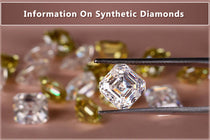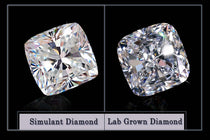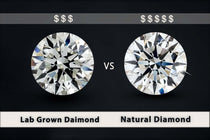Man made diamonds are widely trendy. Synthetic diamonds are more well liked than ever, whether as a sustainable alternative to traditional engagement rings or as reasonably priced diamond jewelry.
What Are Man-Made Diamonds?
Man made diamonds are those created by humans. They are formed of carbon, just like genuine diamonds mined from the soil. They are also quite smart. For diamond engagement rings and fine jewelry, mined diamonds are no longer the only option. Technology advancements, along with environmental and moral issues, have made alternatives not only preferable but also acceptable. For heirloom quality jewelry, you may now select between man made diamonds and diamond imitators.
Man made diamonds produced in laboratories, often known as synthetic diamonds or artificial diamonds, are chemically equivalent to diamonds extracted from the earth, but they are not natural diamonds. Modern technology that mimics the natural process of carbon crystallization is used to manufacture synthetic diamonds that are grown in a laboratory. Since they are composed of the same substance as mined diamonds, they share all of the characteristics of diamonds, including defects and grading, as well as their chemical and optical qualities.
Man made diamonds, commonly referred to as synthetic diamonds or artificial diamonds, are better for the environment, better for employees, and better for you because they offer high quality at a lesser price. You can work with Diamondrensu to create the lab diamond engagement rings of your dreams out of man-made diamonds, or you can buy a loose man-made diamond from them.
ALL SHAPES OF LAB CREATED DIAMONDS aka ARTIFICIAL DIAMONDS
What issues Do You Have When Purchasing Man-Made Diamonds?
Lab Grown Diamonds do not retain value over time
A natural diamond is an investment since it will hold its value over time. The case with lab grown diamonds is different.
Lab grown diamonds are artificial diamonds that are produced in a laboratory or factory, as we previously explained. The technology is brand new, "cutting edge," and costly right now.
However, it's important to keep in mind that historically, any new technology starts out being pricey before becoming more streamlined and ultimately becoming relatively affordable. This implies that lab grown diamonds may become relatively affordable in the future, which would cause the value of ones bought now to drastically decrease.
The supply of lab grown diamonds will always be plentiful because they are not finite like their natural counterparts. As a result, there is no assurance that they will retain any value in the future.
So let's examine an illustration. Let's say that, in today's market, a 1-carat lab grown diamond costs $5,000 rather than $7,000 for a genuine one. Buying a lab-grown diamond can save you some money today, but it might be worth virtually nothing in the future. In contrast, a natural diamond that you buy will always be worth what you paid for it.
Man made Diamonds, Aka Artificial Diamonds, Lose the Appeal of Mined Diamonds
You give up some of the allure, wonder, and "it factor" that comes with a genuine diamond. Some people might think this one is frivolous, but there is something wonderful in knowing that your diamond has a long history and heritage.
Going back hundreds of years, our ancestors, their ancestors, and so on wore natural diamonds. Before a natural diamond was discovered and brought to light, it probably spent millions of years under pressure and being purified by processes of the earth. When you contrast this with the sterile setting of a contemporary lab, some of the romance is lost.
People might not understand
It's possible that many people are unaware of what a lab grown diamond is. Naturally, you don't have to disclose to anyone that you purchased a lab grown diamond (and even experienced gemologists might not be able to tell). But because of the false information we discussed before, few people are aware of what a lab grown diamond is. They might assume you were being cheap by selecting a CZ or a fake diamond over a genuine one.
Why Would You Just Choose Man-Made Diamonds?
Lab Grown Diamonds are “Real” Diamonds
Contrary to popular belief, lab-grown does not equate to faked. The similarities between a lab grown diamond and a natural diamond are almost uncanny. Therefore, investing in a lab-grown diamond is better than choosing a man made alternative like cubic zirconia.
Chemically and physically, a diamond created in a lab is a diamond. It is produced utilizing technology that mimics the growth of natural diamonds in a controlled environment. Natural and lab-grown diamonds have identical appearances. Their origin is the only distinction.
The characteristics of natural and lab grown diamonds, such as hardness, are substantially the same. Natural and lab grown diamonds both rate a 10 on the Mohs scale. This implies that you can wear a lab grown diamond every day with the same confidence as you would a real diamond.
Lab Grown Diamonds are Less Expensive
The cost is another benefit of lab grown diamonds. Even while lab grown diamonds are not cheap, they might be reasonably priced when compared to comparable natural diamonds. Although the capital expenditures of lab grown diamonds are comparable to those of natural diamonds, the supply chain is far shorter. Since lab grown diamonds don't go through the mining process, fewer hands come into contact with them along the road, which ultimately leads to a less expensive diamond.
The cost of natural diamonds reflects their scarcity. Natural diamonds are formed deep in the earth and must be brought to the surface by volcanic eruptions in order to be mined.
Man made diamonds are not dependent on nature because they are man made (created through a combination of science and technology). As a result, the cost of lab-grown diamonds is lower since they are more plentiful.
Still Unsure about Man-Made Diamonds? Everyone is Asking These Questions
Continuing with us? Still uncertain. You are heard. You're not by yourself, we can guarantee you. So, we've compiled the most common queries we overhear from couples thinking about lab grown diamonds.
Are man made diamonds valuable?
They are worth what people are willing to pay for them, which is currently about 60% less than natural diamonds. Are they worth the money? Natural diamonds aren't either. Are they lovely, sparkly representations of your love story? Absolutely.
Are man-made aka artificial diamonds genuine?
Absolutely. As previously stated, man-made diamonds are genuine diamonds. Atomically, optically, and physically. They may be referred to as microwave diamonds, phony diamonds, or any number of other derogatory terms by the diamond business, but in actuality, they are genuine diamonds that were simply born in a different environment.
Are artificial diamonds appropriate?
Natural diamonds are comparable. The range of qualities that apply to both natural and man-made diamonds is the same. You have the option of purchasing a cheap, heavily included warmer color lab diamond or a super white internally flawless one.
Is it worthwhile to invest in an artificial diamond?
We believe so! It's all about getting the look you want for the price you want to pay. Some couples prefer to sacrifice clarity and color for provenance, while others prefer to go big on carats. There are no correct or incorrect answers here; only what is best for you.
Is every man-made diamond the same?
While we would prefer that all man-made diamonds be D-flawless, this is not the case. Diamonds grown in laboratories are not all the same. They are grown or formed in a manner similar to how diamonds form in nature. That means that inclusions and color variations are the norms.















